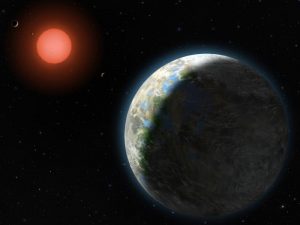In the fairy tale, Goldilocks was a little girl who walked into a house in the forest. She ate porridge, sat in chairs, and slept in beds. The first choices she tried were too hot, too big, and too hard. Her second choices were too cold, too big, and too soft. Her third choices were all “just right.”
The story of Goldilocks is a good metaphor for finding planets that can harbor life. Some are too close to their stars (too hot), some are too far from their stars (too cold), and some are just the right distance from their stars (not too hot or too cold).
In September 2010, planet-hunting scientists from the University of California Santa Cruz and the Carnegie Institution of Washington found such a “Goldilocks” planet. Does this planet, dubbed Gliese 581g, have life? Maybe, maybe not. Even if it did have life, it’s unlikely to look like the fictional movie and television versions of aliens.
Much like the movies and televisions, artists’ representations of planets (like Lynette Cook’s version of Gliese581g, courtesy of NASA, at left) are also fantasy. Gliese 581g is close to 19 billion kilometers from Earth–far too far away for any visual sightings with a telescope!
Still, the ability to find planets that are in habitable Goldilocks zone orbits is amazing in itself! While scientists have been able to find planets for a while, most of the planets discovered have been very large. After all, those are the easiest ones to detect with the current technology. As telescope technology advances, scientists should be able to detect smaller and smaller planets, some of which might be more like Earth.
Even if scientists never find planets with living organisms, the advances in technology and the information we learn about other solar systems will only help us to better understand our own planet and the wide variety of organisms with which we share it.
Read about the discovery at: http://www.nasa.gov/topics/universe/features/gliese_581_feature.html
Learn how scientists find new planets and practice finding your own in our newest High-Adventure Science curriculum module: “Is there life outside of Earth?“
